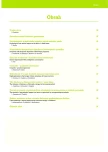Diagnostic and therapeutic algorithm of heterotopic pregnancy
Authors:
R. Vavrušová; R. Hudeček; B. Kuřecová; P. Ventruba
Authors‘ workplace:
Gynekologicko-porodnická klinika LF MU a FN Brno
Published in:
Prakt Gyn 2007; 11(2): 66-69
Overview
Heterotopic pregnancy is defined as concomitant incidence of intrauterine and ectopic pregnancy. The most often referred rate of incidence of heterotopic pregnancy ranges between 1 per 20,000 and 1 per 30,000 cases of intrauterine pregnancy. However, progress in assisted reproduction has caused dramatic increase in the risk of heterotopic pregnancy, especially in association with in vitro fertilisation (IVF), embryotransfer (ET) of more embryos and intrauterine insemination (IUI). The incidence of heterotopic pregnancy within assisted reproduction ranges between 0.75 and 2.9 %.
Objective:
Presenting of a diagnostic and therapeutic algorithm for heterotopic pregnancy using 2 casuistics and providing a self-contained overview of the above issue. Material and method: 2 reference heterotopic pregnancy casuistics following IVF/ET with different clinical courses; diagnostic algorithm, surgical treatment and subsequent release of patients.
Conclusion:
Attention should be given to the risk of heterotopic pregnancy in all incipient pregnancies following IVF/ET and intrauterine insemination. In case of suspected heterotopic pregnancy, the patient should be hospitalised, and ultrasound examination and monitoring of serum hCG level dynamics should be performed. Timely surgical intervention is the necessary condition for excluding the risk of posthemorrhagic shock due to tube rupture. In addition, early intervention helps to sustain and carry forward intrauterine pregnancy.
Key words:
heterotopic pregnancy – in vitro fertilisation – intrauterine insemination – embryotransfer
Sources
1. Ventruba P, Čupr Z, Pilka L et al. Faktory sdružené se vznikem mimoděložního těhotenství po fertilizaci in vitro a transferu embrya. Asist Reprod 1992; 2 : 10-11.
2. Cario GM, Carlton MA. An unusual set of triplets: twin intrauterine pregnancy with singleton extrauterine pregnancy. Auster N Zeal J Opst Gynaecol 1984; 24 : 51-54.
3. Fernandez H, Fournet P, Leelaidier C et al. Nonsurgical treatment of heterotopic pregnancy: a report of six cases. Fertil Steril 1993; 60 : 428-432.
4. Franke C, Rohrborn A, Thiele H et al. Combined intrauterine and extrauterine gestation. A rare cause of acute abdominal pain. Arch Gynecol Obstet 2001; 265 : 51-52.
5. Peršín J, Pospíchal J, Hanousek L. Úspěšná laparoskopická léčba heterotopické gravidity po spontánním otěhotnění. Gynek po Prom 2004; 6 : 55-56.
6. Citterbart K et al. Gynekologie. Praha: Galén 2001 : 189-193.
7. Reece EA, Petrie RH, Sirmans MF. Am J Obstet Gynecol 1983; 146 : 323-329.
8. Dickey RP, Holtkamp DE. Development, pharmacology and clinical experience with clomiphene citrate. Hum Reprod Update 1996; 2 : 483-506.
9. Glassner MJ, Aron E, Eskin BA. Ovulation induction with clomiphene and rise heterotopic pregnancies. A report of two cases. J Reprod Med 1990; 35(2): 175-178.
10. Bello G, Schonholz D, Moshirpur J et al. Combined pregnancy: the Mount Sinai Experience. Obstet Gynecol Surv 1986; 41 : 603-613.
11. Hudeček R. Analýza faktorů ovlivňujících výsledky AR pomocí systémů pro dolování znalostí z databází SHLUK a neuronové sítě Neul 3. Závěrečná zpráva, grant IGA MZČR č. 4916-3; 2001.
12. Magdolinič M, Lukáč V, Kubalík L. Heterotopická gravidita – úspešný laparoskopický management s pokračujúcou intrauterinnou graviditou. Gynekolog 1998; 2 : 28-31.
13. Fernandez H, Gervaise A. Ectopic pregnancies after infertility treatment: modern diagnosis and therapetic strategy. Hum Reprod Update 2004; 10 : 503-513.
14. Hulvert J, Mardešič T, Vobořil J et al. Heterotopická gravidita a její výskyt v souvislosti s asistovanou reprodukcí. Čes Gynek 1999; 64 : 299-301.
15. Veselý J, Ventruba P, Veselá K. Duplicitní intrauterinní a ektopická gravidita po IVF/ET. Asist Reprod 1992; 2 : 12-13.
16. Goldberg JM, Bedaiwy MA. Transvaginal local injection of hyperosmolar glucose for the treatment of heterotopic pregnancies. Obstet Gynecol 2006; 107 : 509-510.
Labels
Paediatric gynaecology Gynaecology and obstetrics Reproduction medicineArticle was published in
Practical Gynecology

2007 Issue 2
Most read in this issue
- Cerazette – practical experience
- Psychological and medical aspects of the birth of a dead foetus
- The influence of tibolonee on fibrocystic changes in the mammary gland
- Bisphosphonates in the therapy of bone metastases of breast carcinoma
